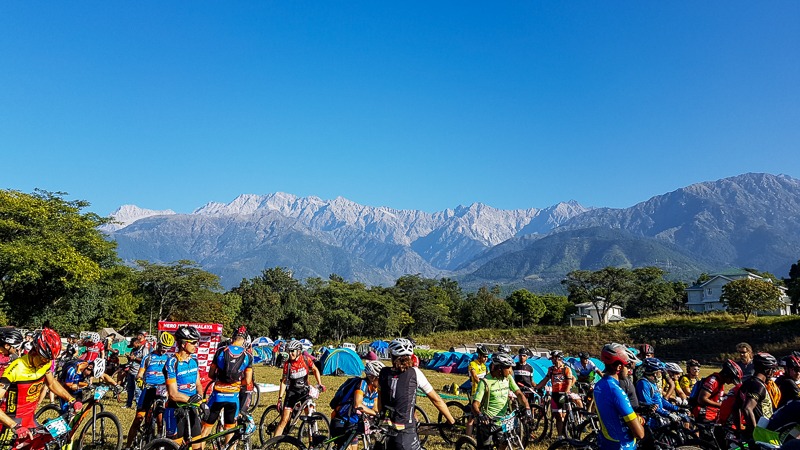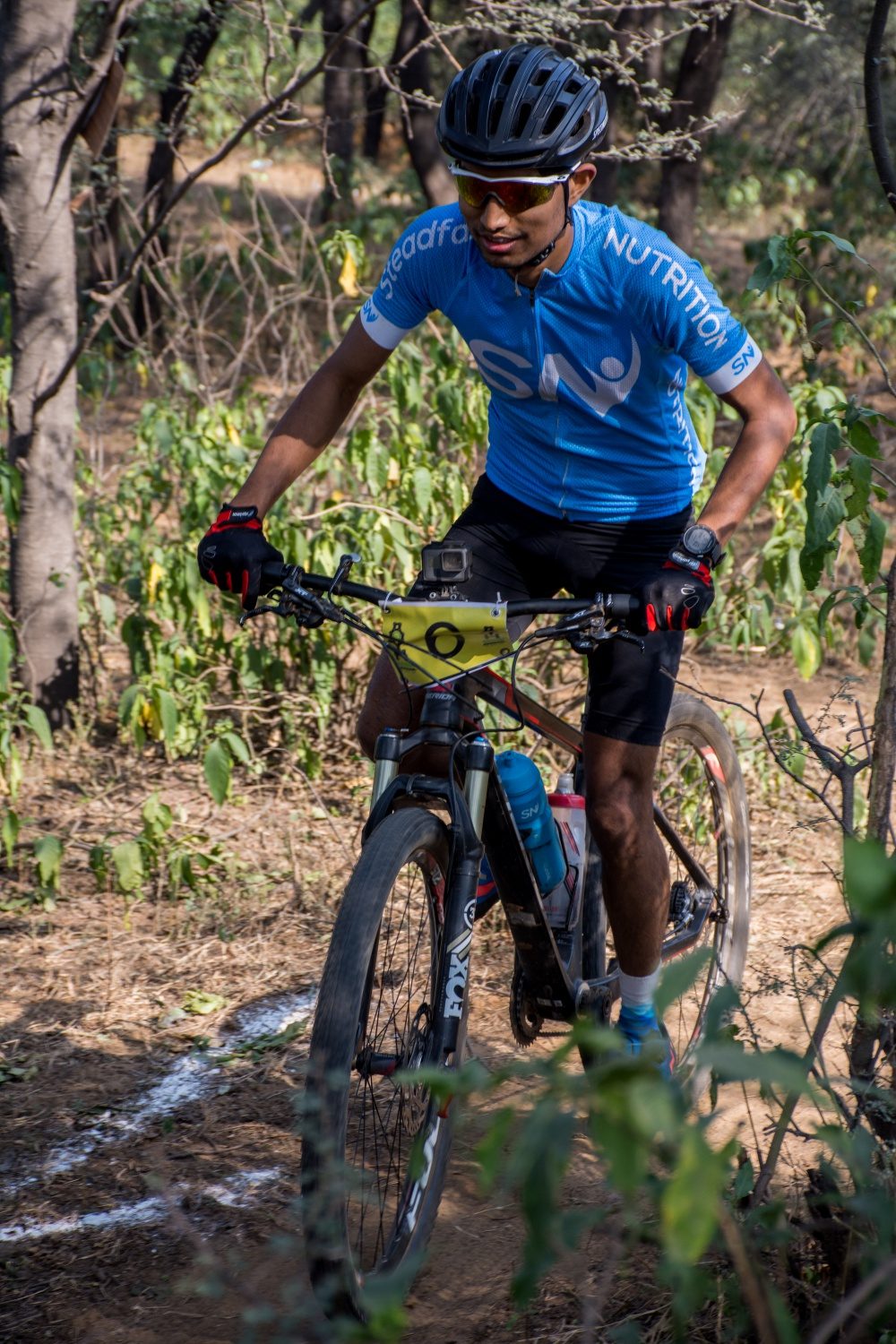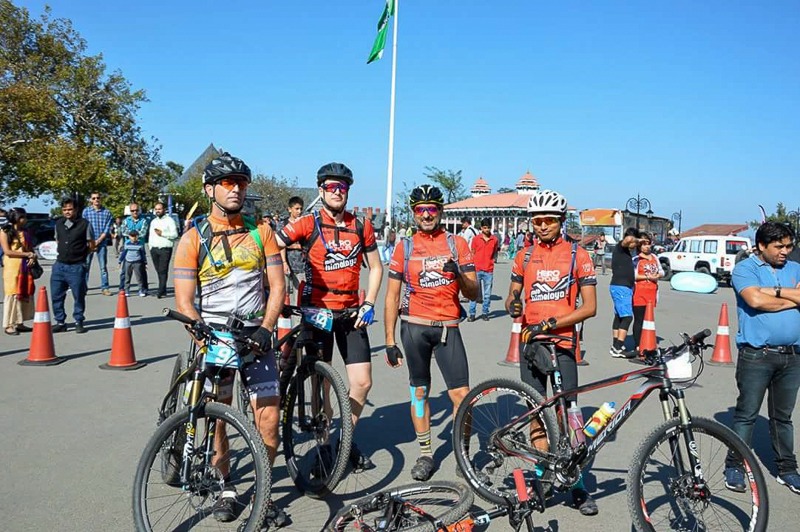MTB Himalaya is one of the premier mountain bike races in India. Considered to be the toughest in the country and one amongst the world as well. The race has been conducted every year since 2005 and has seen top participants from around the world.
The gruelling race offers unmatched climbing over its 8 competitive riding days as it starts from Shimla and ends in Dharamshala, Himachal Pradesh. All this nestled in the rugged but picturesque Himalayas.
We chat to Prateek Thakur, about his experience of racing and completing this sufferfest called MTB Himalaya in 2017. He talks about the challenges that an amateur racer faces and the reward of crossing the finish line!
Cycling Monks: What got you into cycling?
Prateek Thakur: I started cycling 2.5 years back and got to know about MTB Shimla through Facebook. It looked interesting so I thought, I should go for it. I registered for the race and then looked for a cycle, I was getting a good deal online, so I bought it three weeks before the race and it got delivered a week before MTB Shimla. I went to India Gate twice with a friend and then went for the race.
Before that I had only cycled as a kid in my hometown, Kullu. At that time we didn’t ride long distances, just near our house. Sometimes we would go uphill, but not a lot.
I had been to Shimla a lot of times, since a lot of relatives live there. I was familiar with the place thought that it would be a good place to start cycling.
CM: How was your first experience of MTB Shimla?
PT: The first time it was very tough. I was walking 50% of the time. They would tell us the distance and elevation at the start of the race. I had no clue about any of it. When the race started I rode where I could, and where the gradient was too steep, I walked!
Even after walking a lot of the course, amongst 100 riders, I still managed to finish in the 60s!
The bike I had was an entry level Merida. I searched online and found that disc brakes are good to have, so I got those! I didn’t even know that something like a suspension lockout existed! My bike had it and I didn’t know. My roommate during the race told me that I could lock the forks on uphills.
I didn’t even know how change a tube at that point of time! Luckily, I didn’t have a flat in the race as I would have had to ask someone else to repair it for me.
CM: How and when did you realise that you are good on an MTB?
PT: The two days of MTB Shimla, even though tough, was a lot of fun. Maybe not on the uphills but on the downhills I enjoyed myself. Even before that I ran half-marathons. Running was on and off. I needed some other sport that I could be more regular at.
After MTB Shimla, I started riding with Noida Cycling Club regularly. I met a couple of riders who rode on weekdays and started riding with them. We would ride 5-6 times a week, covering 50 km a day on MTBs.
Now I don’t manage that mileage!
CM: What was your reason for participating in MTB Himalaya? Did you find the challenge daunting?
PT: I had heard about MTB Himalaya being very tough and demanding. On hearing that I wanted to experience it. I was curious to see how difficult it actually is. That was my reason to participate in it.
The duration and competition present was also a reason for me to participate in the race. Some of the best Indian riders and foreign riders were going to be there.
CM: How did you prepare for MTB Himalaya?
PT: I decided to participate very late, just 2 months before the race.
At that point of time I still had the entry level Merida. I was not sure if it was race ready for MTB Himalaya. So 2 months before the race I talked to Aman Puri and we got a deal with Merida. I upgraded to a race bike.
I got a hardtail. A Merida Big Seven 7000, a hardtail because it was cheaper than a full suspension bike!
I didn’t know anything about training plans at all. I had Strava Premium and knew that it had structured training plans. So I went to Strava and found a plan for 2-3 months. Even though I had inadequate time I followed that plan for one and a half months. I did interval training as well.
Basically I was riding thrice on weekdays and longer rides on weekends. I managed 5 days of riding a week.
CM: How difficult is it to prepare for a race with so much climbing, when living in a flat land like NCR?
PT: Preparing for a Himalayan race in the flats is difficult because you don’t have that elevation gain. You don’t know how your body will react to a particular altitude. At 3000 metres the world is very different. Having to climb 1500-2000 metres daily. I didn’t know that and couldn’t prepare for it.
My focus was to get as fit as possible to complete the race.
CM: Participating in club races like those of Aravalli Trailhunters’, how helpful was it?
PT: The Aravalli Trailhunters races were very helpful for me. I mostly participated in ATH races only. Those are the only trail races in NCR. It helped me improve my technical abilities as well. I was competing with other riders who were much stronger than me. It motivated me to get better and improve myself.
ATH was very helpful in preparing for MTB Shimla and Himalaya.
Gautam Chima was also there for the MTB Himalaya race. We chatted before and during the race. He gave me tips to riding the route like ‘don’t go hard during the first couple of stages’ etc. That really helped.
CM: What were the biggest differences between MTB Shimla and Himalaya?
PT: Obviously the duration and difficulty level is much higher.
But more so in terms of technical skills. In MTB Shimla anyone can go there and finish the race. But for Himalaya you need some good technical skills as well. You will have a at least two Enduro sections in every stage. Those are very tricky sections. If you can ride those sections you save a lot of time, else you lose a lot of time.
I was mostly walking through the Enduro sections! But whatever I could ride I did. On Day 2 there was a lot of downhill and I enjoyed it. There was a long Enduro section and I rode most of it.
It would have been definitely easier if I had a full suspension bike, because it saves you energy.
CM: Was racing MTB Himalaya easier, tougher or as you had expected?
PT: I knew it was tough. But when I actually did it, I realised it was much tougher. Very very tough. The first 4 days were relatively good. I was having fun and finishing the stages within the cutoff time.
But after the 4th day my body completely shut down. The 5th and 6th day it was hard for me to pedal. There were riders on whom I would put an hour in a stage and these guys were going past me. It was very hard. Two stages I remember it was so difficult to pedal on the climbs.
I wasn’t fully prepared for the race. I knew at some point of time it would get difficult. It happened after four days.
CM: What were the most difficult things in the race?
PT: The cold at night was really challenging. Because of the cold I wasn’t able to sleep at night.
The good thing was that whenever I finished a stage I would sleep around an hour and a half. At night it was cold which left me restless.
I hadn’t been living in the hills for 5-6 years and I had lost that mountain weather conditioning.

CM: The most memorable moments from the race?
PT: Meeting new riders and interacting with foreign riders. Some of them were professionals who did it full time. The guy who won the race, I spoke to him for around an hour. He was telling me how much he practices and the cycling culture in his country.
It was good interacting and knowing how it is outside.
CM: How does it feel to have raced alongside some of the best MTB racers in the world?
PT: (Laughs) I would just see them at the start line and then again when we had dinner! I wouldn’t see them in between that.
But it was good to race against some other strong riders. There were a couple of riders who had a similar pace as mine and we would keep passing and re-passing each other.
It was nice to race with them. Though mostly I was riding solo!

CM: How did you feel when you crossed the finish line?
PT: The last stage was the toughest for me. It was supposed to be the easiest stage!
Elevation gain and distance wise it was easy. 50 km and 1500 metres of climbing. Else, we climbed 2000-2500 metres daily.
On that stage after 20 km, everyone was riding easy. On a downhill I somehow cut my rear tyre. There was a sidewall tear which I didn’t realise. I just realised it wasn’t sealing and with a friend of mine we put a spare tube. But the tyre was so tight that we accidentally cut the tube with the tyre levers. We wasted around 50 minutes there. The other rider was also getting late, so he left.
I walked with my bike for an hour.
On that day it was a short stage and they wanted everyone to reach on time to have the ceremony in the evening. They had kept the cut off at feed stations as well. On previous days the cutoff was only at the end.
12 PM was the cutoff for the first feed station. Mechanical help was available after the feed station.
I had still some distance to go and it didn’t look like I would make it on time.
There was a rider who went past me and then I saw him sitting under a tree. I talked to him and he was a military guy. He was looking tired. I asked him if I could borrow his bike, since I had completed all the stages. He hadn’t completed other stages and was too exhausted to continue. So we exchanged bikes.
But his bike had 26″ wheels and the suspension wasn’t working!
Just a kilometre later there was the feed point, after which there was an enduro section. As I was entering the Enduro section, one of the marshals called out for me to stop, since I was past the cutoff time. But I ignored him and continued riding.
I had to walk most of that enduro section because it wasn’t the best bike to ride on that stretch.
There was a 5 km climb to the finish line. When I started the last climb, I could see other riders coming down. There cheered me on.
The finish time was 3 pm and I had 20 minutes to go. I was putting in everything I had to climb as fast as possible. The last one kilometre to the finish line was an under construction road, so it was filled with loose gravel.
As I pedalled through that, the chain broke! The last 1 kilometre I was pushing the bike with an eye on the clock.
I crossed the finish line with just one and a half minutes to go.
CM: What mistakes did you make, which you would like to improve upon?
PT: My tyres didn’t have sidewall protection. I had Maxxis Ikon but without any protection. Next time I will definitely go with better tyres.
I want to be better prepared for the race, I don’t want to exhaust after 3-4 stages like this time. I want to be more consistent through the stages and finish each stage strong.
CM: Advice for an amateur who wants to race.
PT: Even though it is a tough race, you should definitely ride and give it a go and enjoy yourself. Even if you don’t finish it, you will have a lifetime experience.
CM: Which is the next big race you would love to participate in?
PT: I might do MTB Himalaya again this year but apart from that I don’t think I will do any other big race.
There is MTB Arunachal as well, but that is too far away.
If you would like to register for the MTB Himalaya 2019 race, go here. For a first timer’s perspective of MTB Shimla, click here. To know about Aravalli Trailhunters’ community racing, go here. To race in ATH’s amateur races in an around NCR, join their Facebook Group.






One Reply to “MTB Himalaya Sufferfest with Prateek Thakur!”